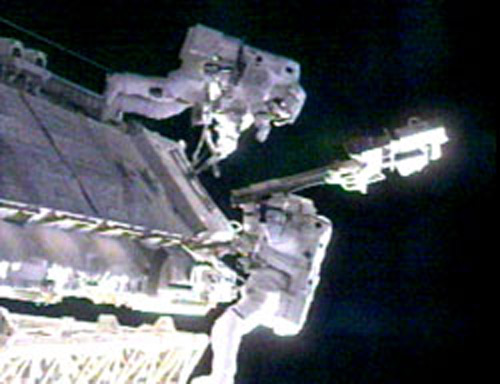NASA Clears ISS for Spacewalks in U.S. Spacesuits

Astronautsaboard the International Space Station (ISS) are once more able to stagespacewalks from their orbital laboratory after U.S. flight controllers cleared aproblematic handrail issue Thursday, NASA officials said.
NASA spokespersonKylie Clem said station managers lifted a month-long spacewalk ban aboard thestation, with a few conditions, after a pair of ISS flight and management meetingstoday at the agency's Johnson Space Center (JSC) in Houston.
Defectsfound in the station's aluminum handrails on the ground prompted ISS flightcontrollers to hold all spacewalks in NASA's Extravehicular Mobility Unit (EMU) suits,Kirk Shireman, the agency's deputy ISS program manager, said Wednesday.
"Thehandrails can be used with a slight variation," Clem told SPACE.com,adding that should a spacewalk be needed, astronauts would use a metal hook tolatch onto the stanchions that connect the rails to the station hull, ratherthan the bar itself. "The analysis will continue to return to normal proceduresthrough mid-April."
No spacewalksare currently scheduled for the space station's present crew, Expedition12 commander Bill McArthur and flight engineer Valery Tokarev, but NASA flightcontrollers wanted to resolve the issue should one be required in the event ofan emergency, NASA officials said.
Corrosionon the aluminum handrail bars, which engineers traced back to improper heatingduring their manufacture, led ISS officials to question the health of handrailsalready installed on the space station's hull. Astronauts use the rails tosecure science experiments and themselves to the outpost's exterior, as well aspull themselves between work stations.
"Oursuspicion is that it's very limited," Shireman said of the problem. "It wasdifficult to say which of the handrails that are currently on orbit had thismaterial problem and which didn't."
Breaking space news, the latest updates on rocket launches, skywatching events and more!
Additional teststo verify the long-term use of the U.S.-built handrails to hold material exposureexperiments are also scheduled for the future, he added.
Meanwhile,four misplaced air scrubbers for the station crew's Russian-built Orlan spacesuitshave also impaired the astronaut's spacewalk capabilities, NASA said.
AdditionalOrlan scrubbers - lithium hydroxide canisters that scrub carbon dioxide fromthe spacesuit's atmosphere - have since been added to an unmanned RussianProgress supply ship to launch spaceward in April. McArthur and Tokarev, whoare nearing the end of their six-month mission, will continue to search for themissing Orlan canisters.
"We arecontinuing to look for them and we believe we will locate them," Shireman said.
The twoastronauts have been packing their Soyuz TMA-7 spacecraft for their April 8 returnto Earth and will hand space station control over to their replacements, Expedition13 commander Pavel Vinogradov and flight engineer Jeffrey Williams.
TheExpedition 13 crew and Brazilianastronaut Marcos Pontes, an eight-day ISS visitor, will launch toward thestation atop a Russian-built Soyuz rocket from Baikonur Cosmodrome inKazakhstan on March 29 at 9:30 p.m. EST (0230 March 30 GMT).
The nextscheduled spacewalks outside the ISS are set during NASA's STS-121shuttle mission, which is slated to launch on earlier than July 1. Thefirst dedicated Expedition 13 spacecraft is expected sometime after thatspaceflight, NASA officials said.
- ISS Astronauts Prepare for Launch and Landing
- Space Station Crew Takes Short Soyuz Trip
- Complete Coverage: ISS Expedition 12
- Complete Coverage: ISS Expedition 13
Join our Space Forums to keep talking space on the latest missions, night sky and more! And if you have a news tip, correction or comment, let us know at: community@space.com.

Tariq is the award-winning Editor-in-Chief of Space.com and joined the team in 2001. He covers human spaceflight, as well as skywatching and entertainment. He became Space.com's Editor-in-Chief in 2019. Before joining Space.com, Tariq was a staff reporter for The Los Angeles Times covering education and city beats in La Habra, Fullerton and Huntington Beach. He's a recipient of the 2022 Harry Kolcum Award for excellence in space reporting and the 2025 Space Pioneer Award from the National Space Society. He is an Eagle Scout and Space Camp alum with journalism degrees from the USC and NYU. You can find Tariq at Space.com and as the co-host to the This Week In Space podcast on the TWiT network. To see his latest project, you can follow Tariq on Twitter @tariqjmalik.
